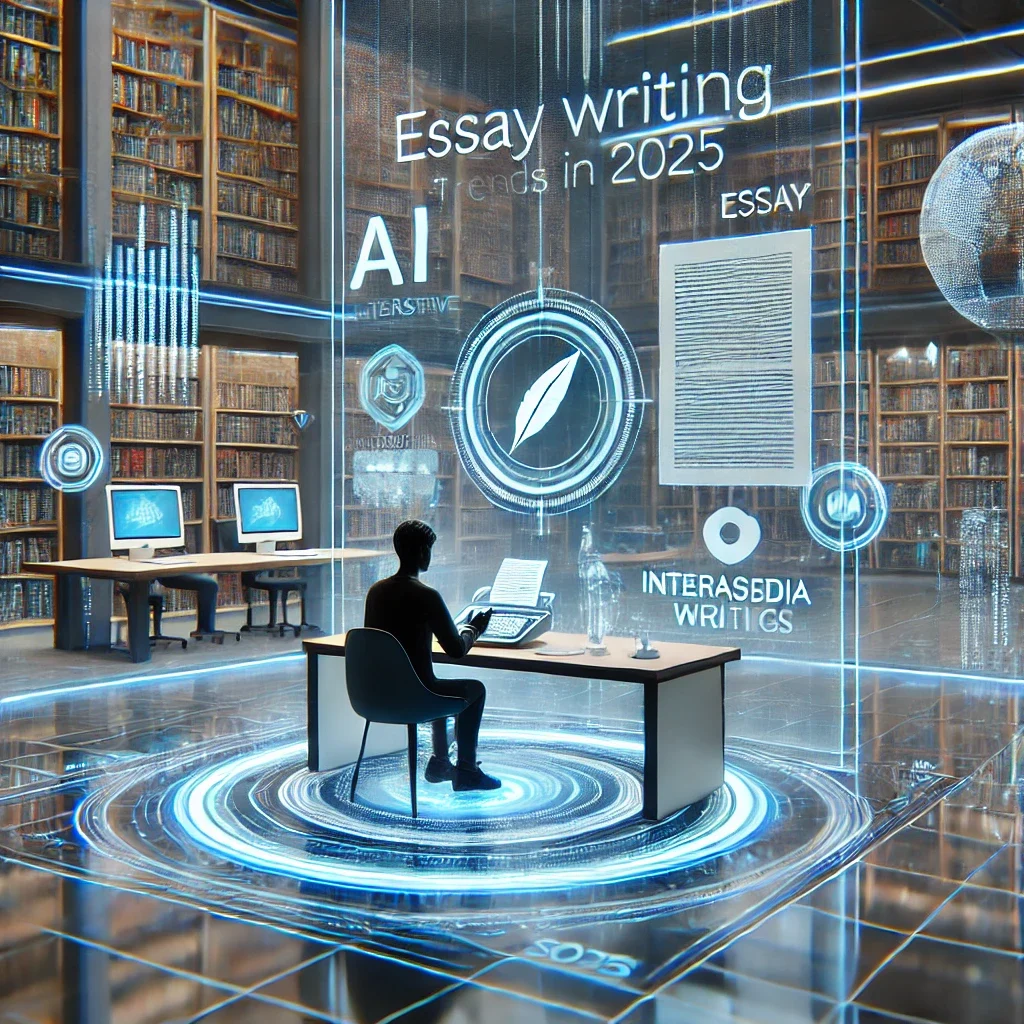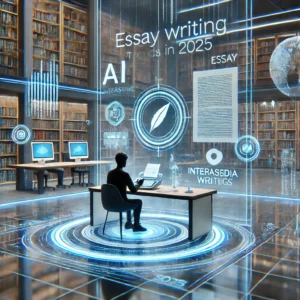Table of Contents
Latest Essay Writing Trends for 2025
Introduction
The landscape of essay writing is evolving rapidly, influenced by technological advancements, cultural shifts, and educational standards. As we step into 2025, it is crucial for students, educators, and writers to stay abreast of these changes to enhance their writing skills and produce more impactful essays.
Academic writing has traditionally focused on structured arguments, critical thinking, and analytical depth. However, modern technological advancements, the demand for inclusivity, and the increasing reliance on artificial intelligence (AI) tools are transforming how essays are conceived, written, and evaluated. This article explores the latest essay writing trends, focusing on the integration of multimedia, the rise of narrative and personal essays, the importance of cultural and social awareness, and the growing role of AI in essay writing. Understanding these trends will allow students and educators to adapt and improve their writing practices, ensuring that they remain relevant and effective in an increasingly digitalized and interconnected world.

1. Use of Multimedia in Essays
Multimedia essays are revolutionizing traditional writing by incorporating visual and auditory elements to create more engaging and immersive narratives. While essays have traditionally been text-based, modern technological advancements allow students to incorporate various multimedia elements, making their work more dynamic and impactful.
Integration of Videos and Images
Visual elements such as images, infographics, and videos can break the monotony of text and provide a more comprehensive understanding of the topic. Instead of merely describing a concept, students can include a relevant image, a graph, or even a short video clip that supplements their argument. This trend is particularly relevant for subjects such as history, science, and social studies, where visual representation enhances comprehension.
For example, an essay on climate change might feature interactive infographics illustrating rising global temperatures, expert interviews explaining the impact of deforestation, and real-time data visualizations showing the effects of carbon emissions. Such elements not only enhance engagement but also make complex ideas more accessible.
Interactive Elements
Embedding quizzes, polls, and interactive maps can enhance reader engagement and make the essay more dynamic. This is particularly useful for online essays and research presentations, where audience participation can reinforce learning and retention. Interactive tools allow readers to actively engage with the content rather than passively absorb information.
For example, in an essay about global poverty, interactive maps displaying real-time statistics on economic disparity across different countries can provide a clearer perspective than static descriptions. Such elements add depth and interactivity to traditional essays, making them more appealing and informative.
The Role of Digital Storytelling
Digital storytelling is another aspect of multimedia essay writing that is gaining traction. It allows students to present their research in the form of a compelling narrative enriched with multimedia elements. This approach is particularly effective in journalism, social sciences, and literature, where storytelling enhances understanding and emotional connection.
2. Rise of Narrative and Personal Essays
Narrative and personal essays are gaining popularity due to their ability to connect with readers on a deeper, more personal level. Unlike traditional academic essays that focus primarily on analysis and argumentation, narrative essays allow for a more expressive and engaging writing style.
The Storytelling Approach
A storytelling approach involves using personal experiences, anecdotes, and compelling narratives to illustrate a point. This method is particularly effective in personal statements, reflective essays, and creative writing assignments. By weaving real-life experiences into the essay, writers can create more engaging content that resonates with the audience.
For instance, a student writing about resilience could share a personal story about overcoming adversity instead of simply defining the concept. This approach humanizes the essay and makes it more relatable to the reader.
Authenticity and Emotional Appeal
Readers today value authenticity and emotional connection. Personal essays allow writers to express their thoughts, emotions, and perspectives in a way that traditional essays do not. This trend is especially relevant in college admissions essays, where applicants are encouraged to showcase their individuality and unique experiences.
Furthermore, the use of literary devices such as metaphors, similes, and imagery adds depth to narrative essays. A well-crafted story can make an argument more persuasive and leave a lasting impression on the reader.
The Influence of Social Media on Narrative Writing
With the rise of platforms such as Medium and Substack, more writers are embracing personal and narrative essays. Social media influencers, bloggers, and journalists often use storytelling techniques to communicate ideas effectively, making this style increasingly relevant in academic settings.
3. Importance of Cultural and Social Awareness
In an increasingly diverse world, cultural and social awareness is essential in essay writing. Writers are expected to reflect inclusivity, address contemporary social issues, and demonstrate an understanding of diverse perspectives.
Inclusivity in Writing
Diversity and inclusivity are becoming central themes in academic and creative writing. Educators encourage students to explore different cultural perspectives and ensure their essays represent varied voices. This shift aligns with broader societal efforts toward inclusivity and equality.
For example, an essay on feminism should acknowledge diverse feminist movements across different cultures instead of focusing solely on Western perspectives. Recognizing global viewpoints makes essays more comprehensive and intellectually rigorous.
Addressing Contemporary Social Issues
Modern essay topics increasingly focus on pressing social issues such as climate change, racial justice, gender equality, and digital ethics. Essays that engage with current events and global challenges demonstrate awareness and relevance.
For instance, an essay discussing the impact of immigration policies could incorporate real-life narratives from immigrants, historical context, and an analysis of current legislation. This approach not only enhances the essay’s credibility but also fosters critical thinking and social responsibility.
Ethical Considerations in Essay Writing
Writers must be mindful of ethical considerations when discussing cultural and social issues. Misrepresentation, bias, and cultural insensitivity can undermine an essay’s credibility. Students are encouraged to conduct thorough research, cite diverse sources, and approach sensitive topics with nuance and respect.
4. AI Integration in Essay Writing
Artificial intelligence is transforming essay writing by offering tools that enhance efficiency, creativity, and quality. The integration of AI in writing has revolutionized how students approach research, drafting, and editing.
AI-Powered Content Generation
AI tools such as ChatGPT, Grammarly, and Jasper can help students brainstorm ideas, generate outlines, and refine their arguments. These tools provide instant feedback on grammar, coherence, and style, making the writing process more efficient.
For example, a student struggling to start an essay on renewable energy can use AI to generate an outline, key points, and supporting arguments. This initial structure provides a foundation upon which the student can build a well-researched essay.
Automated Editing and Proofreading
AI-driven editing tools analyze text for grammatical errors, stylistic inconsistencies, and readability issues. Automated proofreading enhances writing quality and ensures academic rigor. These tools also help non-native English speakers improve their writing fluency and coherence.
AI in Research and Citation Management
AI-powered research tools can assist students in gathering relevant sources, summarizing key findings, and organizing citations. Platforms such as Zotero and EndNote streamline citation management, reducing the time spent formatting references manually.
However, students must use AI responsibly and avoid over-reliance. Critical thinking, originality, and ethical considerations remain paramount in academic writing.

Is Homework Taking Up all Your Time and Energy?
Start applying these proven tips and techniques to excel in your academic writing. We provides top-notch study resources, writing assistance, and homework help to make learning stress-free.
Order NowConclusion
As we navigate the essay writing landscape in 2025, it is evident that the integration of multimedia, the rise of narrative and personal essays, the importance of cultural and social awareness, and the growing role of AI are shaping the future of academic writing. These trends enhance engagement, inclusivity, and efficiency, allowing students to produce high-quality essays that resonate with readers and meet evolving educational standards.
By embracing these developments, writers can create compelling, insightful, and impactful essays that reflect the dynamic nature of modern academia. As technology and societal values continue to evolve, so too will the art of essay writing, ensuring that it remains a vital and relevant form of communication in the digital age.


